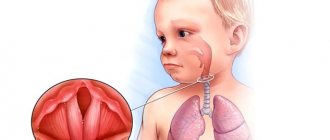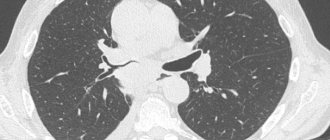Primary appointment/consultation with a gynecologist—RUB 1,700. Repeated appointment/consultation with a gynecologist—RUB 1,200. See all prices
+7 (499) 400-47-33
- Causes and mechanism of ovarian apoplexy
- Symptoms of ovarian apoplexy
- Diagnosis of ovarian apoplexy
- Treatment of ovarian apoplexy
Ovarian apoplexy is a hemorrhage in the ovary that can rupture the ovary and cause internal bleeding. Ovarian apoplexy is an acute, often life-threatening condition that requires immediate medical intervention.
Causes and mechanism of ovarian apoplexy
During the menstrual cycle, a follicle begins to develop in a woman’s body, from which a formed egg will subsequently be released. In place of the follicle, the so-called “corpus luteum” appears - a formation that is involved in preparation for pregnancy. If pregnancy does not occur, the corpus luteum begins to reverse development and decreases. But in some cases this does not happen, the corpus luteum grows, and its cysts may appear. Often the cause of ovarian apoplexy is a rupture of the corpus luteum or its cyst.
In healthy ovaries, apoplexy is not a common occurrence. As a rule, the walls of the ovaries and blood vessels are pathologically changed due to various inflammatory diseases and their consequences.
Violations of the integrity of the ovary can be provoked by physical activity, trauma (especially abdominal trauma), sexual intercourse, etc.
What kind of prevention should be carried out?
In order for a woman not to suffer the sad fate associated with this pathology, it is necessary to take care of her health. Even if you feel excellent, go to the gynecologist for an examination every six months. If there are gynecological problems, be observed regularly. Patients with adnexitis, oophoritis, polyendocrine syndrome or STDs must definitely treat their disease.
Women who have suffered from ovarian apoplexy should take care to ensure that there is no relapse. One of the preventive measures is complex treatment to normalize the menstrual cycle and improve blood supply.
Patients who have undergone surgery are required to monitor the restoration of hormonal levels and the normalization of blood circulation. They are advised to take nootropics and tranquilizers. Under no circumstances should you refuse such drugs. The use of multiphase oral contraceptives will ensure normalization of hormonal levels and help prevent ovulation. It is better not to plan pregnancy during this period. It is necessary to wait for the body to fully recover and become stronger. Then you can confidently hope for a successful pregnancy and birth of a healthy baby.
Observation by a doctor is considered mandatory.
Diagnosis of ovarian apoplexy
Ovarian apoplexy gives symptoms, which in medicine are usually called “acute abdomen”. The doctor, conducting diagnostic measures, excludes pathologies such as appendicitis, ectopic pregnancy, etc. In most cases, to confirm ovarian apoplexy, the following are carried out:
- Gynecological examination
- Blood analysis
- Ultrasound, thanks to which you can see the presence of blood in the abdominal cavity, as well as the corpus luteum
- Laparoscopy (diagnostic) – examination of the abdominal cavity from the inside, through instruments with cameras inserted into small punctures in the abdomen. If necessary, diagnostic laparoscopy becomes therapeutic, and the doctor takes all necessary measures to stop bleeding and restore the integrity of the ovary.
Symptoms
The disease develops rapidly. A sharp pain occurs in the lower abdomen in the projection to the ovary; it can have a pulling and aching character. The symptom appears when the peritoneum is irritated by blood, so the pain is directly proportional to the volume of blood released.
In addition to abdominal discomfort, women experience characteristic signs of internal bleeding - weakness, nausea, dizziness. Blood pressure drops, cold sweat appears, and in some cases fainting is possible.
Treatment of ovarian apoplexy
The most effective, and often the only, method of treating ovarian apoplexy is surgical. In the vast majority of cases, doctors at the gynecological department of the Central Clinical Hospital of the Russian Academy of Sciences perform laparoscopy. The ovarian rupture is sutured, and if a cyst is detected, its capsule is removed. Or coagulation of the site of ovarian rupture is carried out. The consequences of bleeding into the abdominal cavity (blood clots), which could subsequently form adhesions, are eliminated. In extremely rare cases, when absolute indications are identified, doctors remove the ovary.
Conservative treatment of ovarian apoplexy, as a rule, is not carried out.
After surgery, patients may be prescribed physiotherapeutic procedures or other methods from the arsenal of rehabilitation medicine to ensure maximum rapid recovery. Drug therapy is selected individually.
Rehabilitation after treatment
Rehabilitation measures after an ectopic pregnancy should be aimed at restoring reproductive function after surgery. These include: prevention of adhesions; contraception; normalization of hormonal changes in the body. Physiotherapeutic methods are widely used to prevent adhesions:
- low frequency alternating pulsed magnetic field,
- low frequency ultrasound,
- currents of overtonic frequency (ultratonotherapy),
- low intensity laser therapy,
- electrical stimulation of the fallopian tubes;
- zinc electrophoresis, lidase,
- pulsed ultrasound.
During the course of anti-inflammatory therapy and for another 1 month after its completion, contraception is recommended, and the issue of its duration is decided individually, depending on the patient’s age and the characteristics of her reproductive function. Of course, a woman’s desire to preserve reproductive function should be taken into account. The duration of hormonal contraception is also very individual, but usually it should not be less than 6 months after surgery.
After completing rehabilitation measures, before advising the patient to plan the next pregnancy, it is advisable to conduct a diagnostic laparoscopy, which allows you to assess the condition of the fallopian tube and other pelvic organs. If no pathological changes are found during control laparoscopy, the patient is allowed to plan a pregnancy in the next menstrual cycle.
ALBAMED
WHAT IS OVARIAN APOPLEXIA
- Ovarian apoplexy (apoplexia ovarii) is defined as a sudden hemorrhage into the ovary due to rupture of the vessels of the Graafian vesicle, ovarian stroma, follicular cyst or corpus luteum cyst, accompanied by a violation of the integrity of the ovarian tissue and bleeding into the abdominal cavity.
Ovarian apoplexy usually occurs between the ages of 14 and 45 years, most often between 20 and 35 years. However, there are known cases of hemorrhage into the ovary in little girls. The frequency of ovarian apoplexy among gynecological pathologies is 1-3%. Recurrence of ovarian apoplexy reaches 40-70%.
MECHANISM OF DEVELOPMENT OF OVARIAN APOPLEXIA
In the ovaries of a sexually mature woman, follicles grow and the eggs in them mature, that is, preparation for the upcoming pregnancy. From the beginning of the menstrual cycle, the dominant follicle begins to grow, which by the middle of the menstrual cycle reaches its maximum size - about 20 mm. Then the follicle membrane ruptures, releasing a mature egg - ovulation occurs. In place of the burst follicle, a temporary formation is formed - the corpus luteum, which produces certain hormones that prepare the woman’s body for pregnancy. This is the normal course of the ovarian cycle.
With dystrophic and sclerotic changes in ovarian tissue, which occur during acute and chronic inflammatory processes in the uterine appendages, with polycystic ovary syndrome, adhesions and some other diseases, as well as with drug stimulation of ovulation, certain disturbances occur in the process of ovulation and the formation of the corpus luteum. As a result, the blood vessels at the site of the ovarian rupture contract poorly, intra-abdominal bleeding continues and intensifies, and in the corpus luteum, due to the fragility of the vessels, a hemorrhage is formed - a hematoma. All this is accompanied by pain, weakness, dizziness, nausea, vomiting, pale skin, and fainting. Without appropriate treatment, internal bleeding can intensify, creating a real threat to the health and life of a woman.
CAUSES OF OVARIAN APOPLEXIA
Apoplexy has a complex pathogenesis, caused by physiological cyclic changes in blood supply to the pelvic organs. Most researchers identify “critical moments” for ovarian damage. Thus, in 90-95% of patients, ovarian apoplexy occurs in the middle and second phase of the menstrual cycle. This is due to the characteristics of ovarian tissue, in particular with increased vascular permeability and an increase in their blood supply during the period of ovulation and before menstruation.
Apoplexy of the right ovary occurs 2 to 4 times more often than the left, which is explained by the more abundant blood circulation of the right ovary, since the right ovarian artery arises directly from the aorta, and the left one from the renal artery.
Ovarian rupture is primarily predisposed by inflammatory processes in the pelvic organs, leading to adhesions and, as a consequence, sclerotic changes both in the ovarian tissue (stromal sclerosis, fibrosis of epithelial elements, perio-oophoritis) and in its vessels (sclerosis, hyalinosis), as well as congestive hyperemia and varicose veins of the pelvic organs.
Ovarian apoplexy can be promoted by blood diseases and long-term use of anticoagulants, leading to disruption of the blood coagulation system. These conditions create a background for exogenous and endogenous factors leading to ovarian apoplexy.
Among the exogenous causes of ovarian apoplexy are abdominal trauma, physical stress, violent or interrupted sexual intercourse, horse riding, douching, vaginal examination, etc. Endogenous causes of ovarian apoplexy may be incorrect position of the uterus, mechanical compression of blood vessels that disrupts blood flow in the ovary, pressure on the ovary by a tumor, adhesions in the pelvis after surgery, etc. In a number of patients, ovarian rupture occurs for no apparent reason at rest or during sleep.
The leading role in the development of ovarian apoplexy is currently assigned to hormonal imbalances. One of the main causes of ovarian rupture is considered to be an excessive increase in the amount and changes in the ratio of pituitary gonadotropic hormones (FSH, LH, prolactin), which contributes to hyperemia of ovarian tissue.
An important role in the occurrence of ovarian apoplexy belongs to dysfunction of the higher parts of the nervous system, recorded by EEG and REG. As a result of stressful situations, psycho-emotional lability, exposure to environmental factors, living conditions.
Ovarian apoplexy is not only a complex of serious disorders of the reproductive system, but also a disease of the entire body involving various levels of the nervous system.
MAIN TYPES OF OVARIAN APOPLEXIA
There are painful, anemic and mixed forms of ovarian apoplexy.
Currently, the most commonly used classification (Savelyeva G.M.) takes into account the severity of intra-abdominal blood loss:
1. Painful form.
2. Hemorrhagic form:
• I degree - mild (intra-abdominal blood loss does not exceed 150 ml);
• II degree - average (blood loss 150-500 ml);
• III degree - severe (intra-abdominal blood loss more than 500 ml).
OVARIAN APOPLEXIA - SYMPTOMS
The main symptom of ovarian apoplexy is sudden pain in the lower abdomen. Pain is associated with irritation of the receptor field of the ovarian tissue and the effect of escaping blood on the peritoneum, as well as with spasm in the ovarian artery basin. Weakness, dizziness, nausea, vomiting, and fainting are associated with intra-abdominal blood loss.
The painful form of ovarian apoplexy is observed with hemorrhage into the tissue of the follicle or corpus luteum without bleeding into the abdominal cavity. The disease manifests itself as an attack of pain in the lower abdomen without radiating, sometimes with nausea and vomiting. There are no signs of intra-abdominal bleeding.
The clinical symptoms of the painful and mild hemorrhagic forms are similar.
On examination, the skin and visible mucous membranes are of normal color. Pulse and blood pressure are within normal limits. The tongue is clean and moist. The abdomen is soft, although there may be slight tension in the muscles of the anterior abdominal wall in the lower sections. Palpation reveals pain in the iliac region, often on the right; there are no peritoneal symptoms. Percussion free fluid in the abdominal cavity is not determined. On gynecological examination, the uterus is of normal size, the ovary is somewhat enlarged and painful. The vaginal vaults are deep and free. Pelvic ultrasound almost never directly visualizes an ovarian rupture, but it can detect fluid accumulation in the retrouterine (pouch of Douglas) space. In the painful form of ovarian apoplexy, there is a small amount of fluid in the pouch of Douglas; it is hypoechoic with a fine suspension (follicular fluid mixed with blood). There are no pronounced changes in the clinical blood test; sometimes moderate leukocytosis is detected without a shift of the formula to the left.
In the clinical picture of moderate and severe hemorrhagic (anemic) forms of ovarian apoplexy, the main symptoms are associated with intra-abdominal bleeding. The disease begins acutely and is often associated with external causes (sexual intercourse, physical stress, injury, etc.). Pain in the lower abdomen often radiates to the anus, leg, sacrum, external genitalia, and is accompanied by weakness, dizziness, nausea, vomiting, and fainting. The severity of symptoms depends on the amount of intra-abdominal blood loss.
On examination, the skin and visible mucous membranes are pale, and there is cold, sticky sweat on the skin. Blood pressure is reduced, tachycardia. The tongue is dry, the stomach is tense, there may be slight bloating. On palpation, sharp pain is detected in one of the iliac regions or throughout the hypogastrium. Peritoneal symptoms are most pronounced in the lower sections. Percussion determine free fluid in sloping areas of the abdomen (right, left lateral canals).
During a gynecological examination, the vaginal mucosa is of normal color or pale. Bimanual examination may be difficult due to severe tenderness of the anterior abdominal wall. The uterus is of normal size, painful; on the side of apoplexy, a painful, slightly enlarged ovary is palpated. The vaginal vaults hang over, traction on the cervix is sharply painful.
OVARIAN APOPLEXIA - DIAGNOSIS
An ultrasound of the pelvis reveals a significant amount of free fine and medium-dispersed fluid in the abdominal cavity with irregularly shaped structures of increased echogenicity (blood clots).
To diagnose ovarian apoplexy without significant disturbances in general health, puncture of the abdominal cavity is used through the posterior vaginal fornix. However, laparoscopy has become the method of choice in diagnosing ovarian apoplexy. Ovarian apoplexy during laparoscopy looks like an ovulation stigma (a small spot with a diameter of 0.2-0.5 cm raised above the surface with signs of bleeding or covered with a blood clot), in the form of a cyst of the corpus luteum in a “collapsed” state, or in the form of the corpus luteum itself with a linear a rupture or round tissue defect with or without signs of bleeding.
Rupture of an ovarian cyst - consequences for a woman
Due to complications, the patient may develop more far-reaching consequences that affect the quality of future life.
Among them:
- Anemia (anemia due to extensive blood loss during rupture)
- Disorders of the abdominal organs due to the consequences of purulent peritonitis, requiring repeated operations
- Adhesions that increase the risk of ectopic pregnancy or infertility
- Infertility or problems conceiving as a result of complete removal of one ovary
Rupture of an ovarian cyst during pregnancy
It is not uncommon for ovarian cysts to develop during pregnancy.
The consequences of a ruptured ovarian cyst during pregnancy can be dire, including miscarriage or premature birth.
Laparoscopy allows you to remove the cyst at 14-16 weeks of pregnancy - in case of rapid growth of the tumor, which will be confirmed by ultrasound examination.
First of all, it is recommended to undergo removal surgery to avoid rupture of the ovarian cyst for pregnant women with cystadenoma (benign tumor) and endometrioma (“chocolate” cyst). The consequences of rupture of these cysts are the most serious (even hemorrhage into the peritoneum), so they are removed, despite the stage of pregnancy.
Rupture of an ovarian cyst: possible complications
The sooner medical assistance is provided for a ruptured ovarian cyst, the less consequences will be for the female body.
In no case should you ignore the symptoms of a ruptured ovarian cyst, attributing them to a common illness and hoping that they will go away on their own. This can only aggravate the situation, causing infertility (at best).
Complications due to rupture of an ovarian cyst:
- Peritonitis (purulent inflammation of the abdominal cavity)
- Sepsis (blood poisoning)
- Complete removal of the affected ovary
- In some cases, death
Bibliography
- Gynecology: national manual / edited by V.I. Kulakov, I.B. Manukhin, G.M. Savelyeva. – M.: GEOTAR-Media, 2009
- Koivisto, UM, Turtola H, Aalto-Setälä K, et al. The familial hypercholesterolemia (FH)-North Karelia mutation of the low density lipoprotein receptor gene deletes seven nucleotides of exon 6 and is a 115 common cause of FH in Finland // J Clin Invest. – 2005. – No. 90 (1) link
- Gynecology. National leadership / edited by G.M. Savelyeva, G.T. Sukhikh, I.B. Manukhin - M.: GEOTAR-Media, 2022 p. 186-193
- A. D. Makatsaria, Metabolic syndrome and thrombophilia in obstetrics and gynecology / A. D. Makatsaria, E. B. Pshenichnikova. – M.: Medical Information Agency, 2006. – 480 p.
- A.R.Khaibullina, I.V.Sakhautdinova, T.P.Kuleshova, E.M.Zulkarneeva, S.Yu.Muslimova, I.M.Tayupova. Acute abdomen in gynecology textbook for students / Ufa 2014 2nd chapter, page 16.
- Bulletin of KazNMU No. 4 - 2015 B.A.Satogbalina, R.N.Espaeva, L.S.Sakhmuldinova, K.Z.Burychin, D.K.Muratbaeva - Ovarian apoplexy. Etiology. Pathogenesis. Treatment.
- Guide to operative gynecology. V.I. Kulakov, I.D. Selezneva, S.E. Beloglazova - M.: GEOTAR-Medicine - 2005
- Acute abdomen in gynecology. Tutorial. (for general practitioners) Iryshkov D.S. Penza - 2008
- S. Ya. Nazarenko, S. V. Timofeeva. On the issue of management of patients with intra-abdominal bleeding of genital origin. // Kazan Medical Journal – 2014 No. 2
- I. A. Gritsenko, Restoration of the reproductive function of women after ovarian surgery: abstract. dis. ...cand. honey. Sciences: 01/14/01 / Gritsenko Irina Anatolevna. – Volgograd, 2013. – 23s
- Sodnomova, N.V. Ovarian apoplexy, rationale for rehabilitation therapy: author's abstract. dis. ...cand. honey. Sciences: 14.00.01 / Sodnomova Nadezhda Valerevna. – Tomsk, 2008. – 19 p.
- Clinical guidelines (protocol) for the provision of emergency medical care for ovarian apoplexy - All-Russian public organization Russian Society of Emergency Medical Care 2014 - Kazan
- Prevention of pregnancy complications in women of reproductive age undergoing surgery for ovarian apoplexy. T.G. Kravchenko. abstract – Volgograd 2015 – 90-93 s
- Modern concept of providing care to patients with ovarian apoplexy and ruptures of benign ovarian cysts, Ter-Ovakimyan, A.E.: abstract. dis. Dr. med. Sciences: 14.00.01 / Ter-Ovakimyan Armen Eduardovich. – M., 2007 – 36 p.
- Clinical and morphological features of various forms of apoplexy. Kokh L.I., Sodnomova N.V., Kirillov A.V. Tomsk\ Bulletin of Siberian Medicine – No. 1, 2008
- On the issue of etiopathogenesis of ovarian apoplexy. Kokh L.I. Tomsk / magazine “Mother and Child in Kuzbass” - No. 4 (59), 2014











